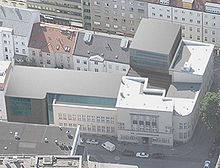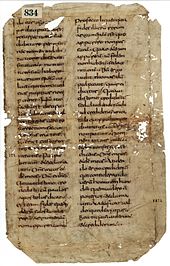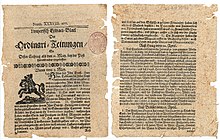Upper Austrian regional library
| Upper Austrian regional library | |
|---|---|

|
|
| founding | 1774 |
| Library type | Regional library |
| place | Linz |
| ISIL | AT-OOeLB |
| Website | http://www.landesbibliothek.at/ |
The Upper Austrian Provincial Library is the central archive library of Upper Austria in the provincial capital Linz . It preserves medieval manuscripts, cradle prints and other prints from the repealed Upper Austrian monastery libraries as well as current non-fiction and specialist literature, fiction and electronic media.
The library was taken over by the federal government in 1999 by the state of Upper Austria . Together with the libraries of the state museums , the state archive and the Stifterhaus , it forms a regional library network of cultural institutions, which is also a partner in the Austrian library network .
tasks
The state library collects, indexes and archives all publications appearing in and about Upper Austria within the framework of the statutory mandate. It acquires a sensible selection from the entire range of printed and electronic media and keeps it ready for use and borrowing and sees itself as a complement to the other library offers from universities and colleges in the region. It preserves, maintains and makes accessible the historically grown book collection of the predecessor institutions bibliotheca publica and the federal study library and safeguards the cultural heritage in terms of security and conservation.
history
1774/78 Jesuit College (kuk Lyzealbibliothek or bibliotheca publica)
The Upper Austrian Regional Library was created in the course of the abolition of the Jesuit order by Pope Clement XIV on July 21, 1773 and the abolition of the monastery under Emperor Joseph II, initiated by the abolition patent of January 12, 1782. More than 20 monasteries in Upper Austria were affected between 1782 and 1792 . Since there was no university in Linz to which one could entrust the book treasures of the monasteries, the imperial decree of July 2, 1774 and October 15, 1774 founded the kk Lyzealbibliothek or bibliotheca publica . The country's first public library initially stayed in the library hall of the former Jesuit college in Linzer Domgasse, but after the building was claimed by the military, it had to move to the imperial palace in accordance with the governor's resolution of August 7, 1776 .
1778/83 castle
When it turned out that the accommodation in the imperial palace was inadequate and that the budgeted financial means were insufficient, the operation of the library was transferred to the Kremsmünster Abbey by a court chancellery decree on April 7, 1783 , with the order to create a public one in one of its houses in Linz To build a library and to carry out the necessary tasks either by his own clergy or to employ the people necessary for this at his own expense. The annual endowments were allocated from the Kameral Study Fund.
1784 Baumgartenberger Stiftshaus (academic library)
The library was moved to the monastery-owned Freihaus at Herrenstrasse 19; in 1784 the emperor designated this building as the residence of the bishop he had appointed and the library had to move again. The house of the abolished Baumgartenberg monastery on Landstrasse 30, today's cloister courtyard , was given to the monastery for this purpose . The move took place in the spring of 1784. This house became the seat of the academic library for 150 years .
1908–1924 Konrad Schiffmann
During this time there were unsuccessful attempts by the Kremsmünster Abbey to get rid of the task. This situation gradually changed when the middle school professor Konrad Schiffmann was entrusted with the provisional management of the library on July 1, 1908. For this purpose, Schiffmann was released from school work, and this was the first time that a state-paid librarian was responsible for the interests of the library. Schiffmann began to put the library on a solid legal basis and to enforce the construction of its own library building. These plans, which were about to be implemented in 1914, fell victim to the First World War . Finally, Schiffmann managed to get the Ministry of Finance to approve the transfer of library staff to state administration in 1922. In 1924 the immediate removal of the library was ordered due to a building inspection of the house at Landstrasse 30, which was requested by Schiffmann himself. The books were packed in boxes and moved to the municipal farm yard.
1934 Schillerplatz (Federal State Study Library)
In December 1930, the construction of what was then the most modern library building in Austria began according to the plans of Ministerialrat Julius Smolik in the New Objectivity style at the Schillerplatz location . The work lasted until December 1931, the move was completed in November 1932 and the new study library was opened on November 9, 1934, despite the fact that the reading room was not yet appropriately furnished, by order of Governor Heinrich Gleißner . From 1935 onwards, Schiffmann's successor, Josef Hofinger, was given the task of implementing the reorganization of the library demanded by the Vienna Central Office, which included the listing of around 80,000 volumes in the magazines according to Numerus Currens . A new catalog of nouns and keywords had to be set up for this purpose.
1938-1950
In 1938 the National Socialist Walter Luegmayer was entrusted with the management of the library. In addition to access through an increased purchase budget, numerous collections were also included in the library's holdings through forced dissolution. After Luegmayer's management came to an end with the American troops marching into Linz on May 5, 1945, Eduard Straßmayr of the Upper Austrian Provincial Archives was appointed provisional director of the study library by a decree of the governor of May 24, 1945, who also took care of the restitution of Responsible for looted property. The annual report notes: “The return of numerous foreign book holdings, such as those that had been confiscated in the study library before 1945, took place little by little.” Overall, the Second World War did not result in any significant losses in the historical collections of the library. In 1950, the Province of Upper Austria founded the Central Catalog of Upper Austria's Academic Libraries , which was housed in the library building and which set itself the task of providing central evidence of regional and academic holdings in Linz's libraries.
1999 Upper Austrian Provincial Library
In 1999 Christian Enichlmayr was entrusted with the management of the library. After discussions and negotiations, the library was taken over by the state of Upper Austria in 1999 and renamed from the federal study library in Linz to the Upper Austrian state library . In 2000, he joined the Austrian Library Association and thus switched to electronic inventory recording (together with the libraries of the Upper Austrian State Museum, the Upper Austrian State Archives and the Adalbert Stifter Institute of the Province of Upper Austria).
On September 5, 2005, the state government decided to renovate and expand the state library and approved the costs for the first construction phase. As a result, an open architectural competition was held, from which the architectural office Bez + Kock (Stuttgart) emerged as the winner. The implementation of the entire construction project was divided into two stages. In October 2007 the foundation stone was laid for the extension, which opened on August 27, 2009. The conversion from a pure storage library to a primarily open open access library that encourages reading and browsing was one of the top planning goals. A modern, future-oriented library was created through careful renovation and expansion.
Collections
The Upper Austria. As a scientific universal library, the State Library collects literature from all fields of knowledge. The stock of books, newspapers, magazines, DVDs, CDs is around 600,000 works. The annual growth is about 10,000 volumes (units). The historical holdings of the regional library come from the following Upper Austrian monasteries, which were dissolved in the 18th century:
- Baumgartenberg (Cistercian, founded 1144)
- Garsten (Benedictine, founded 1107)
- Gleink (Benedictine, founded 1123)
- Linz (Jesuit, founded 1660)
- Linz (Minorites, founded 1669)
- Mondsee (Benedictine, founded 748)
- Münzbach (Dominican, founded 1657)
- Pupping (Franciscan, founded 1477)
- Steyr (Jesuit, founded 1632)
- Suben (Augustinian Canons, founded 1126)
- Traunkirchen (Jesuit, founded 1622)
- Waldhausen (Augustinian Canons, founded 1147)
Manuscripts and incunabula
Manuscripts
530 volumes and 580 smaller ones (including numerous fragments), including many illuminated manuscripts and also what is probably the oldest written document in the Province of Upper Austria from the 9th century (Hs.-834) are in the regional library. The collection also includes numerous manuscripts from modern times, from documents to cookbooks and autographs.
Incunabula (incunabula)
With around 650 incunabula (845 prints) it is the largest collection in Upper Austria and the sixth largest in Austria. The oldest print in Upper Austria. Landesbibliothek is a fragment of a Bible print by Johannes Fust and Peter Schöffer from Mainz , 1462. The oldest complete print is by Johannes Mentelin in Strasbourg , 1466. There are also numerous hand-illuminated prints among the incunabula (including by Ulrich Schreier ).
Regional history (autographs, Upper Austrian newspapers)
Naturally , a special focus of the collections is on the Obderennsia , the regional history holdings (literature from and about Upper Austria). This also includes manuscripts and autographs relevant to regional studies (including by Johannes Kepler , Adalbert Stifter and Anton Bruckner ). Periodicals also occupy a special position. The oldest Upper Austrian newspaper fragment in the regional library comes from the Linzer Zeitung from May 11, 1677.
building
Since the opening of the building in 1934, the striking and listed building on Schillerplatz in Linz, built according to plans by Julius Smolik, Robert Buchner and Matthäus Schlager in the New Objectivity style , has not undergone any major changes.
The main facade bears the two inscriptions “Study Library” and “Upper Austria. State Library ". In between are the four bronze reliefs by Karl Hauk , which represent the four faculties.
In the historical staircase there is a large glass painting, which was suggested by the former library director Konrad Schiffmann and produced by the Linz glass painting company Josef Raukamp . The Wessobrunn prayer depicted on it is interpreted as a poetic document of the first written down of culture.
On the upper floor there is the “Altes Buch experience room” with valuable baroque cabinets from the former Jesuit college.
management
- Wenzeslaus Grumich 1783–1793
- Lukas Fuxjäger 1793–1826
- Anton Viehbäck 1826–1850
- Norbert Mittermayr 1850–1868
- Konstantin Grinzenberger 1868–1874
- Columban Fruhwirth 1874–1882
- Alois Kerschischnigg 1883–1886
- Bruno Kyrle 1887
- Ignaz Schüch 1887-1893
- Gunther Mayrhofer 1893–1906
- unoccupied 1906–1908
- Konrad Schiffmann 1908–1935
- Erich Mayr 1935
- Josef Hofinger 1935–1938
- Walter Luegmayer 1938–1945
- Eduard Straßmayr 1945–1946
- Kurt Vancsa 1948-1969
- Franz Wilflingseder 1969–1985
- Karl Hafner (Mayrobnig) 1985-1998
- Christian Enichlmayr 1999–2016
- Renate Plöchl since 2016
literature
- Cultural heritage in a digital world. Upper Austria. State Library. Catalog for the opening exhibition from July 5 to September 30, 1999. Daktion: Rudolf Lindpointner, Province of Upper Austria, Oö Landesbibliothek, Linz 1999, ISBN 3-9501070-0-2 .
- From the treasure trove of knowledge to a place of learning. 235 years of the “Bibliotheca publica”. Ten years of Upper Austria. State Library. Published by the Upper Austrian Regional Library, editorial staff Christian Enichlmayr, Rudolf Lindpointner, Upper Austria. State Library, Linz 2009, ISBN 978-3-9501070-1-2 ( PDF 7.1 MB ).
further reading
- Günther Androsch : The building history of the Linz study library. Konrad Schiffmann's fight for a new library building. Linz 1985.
- Christian Enichlmayr : Library expansion within the narrow limits of space, money and monument protection. Using the example of the Upper Austrian regional library. In: Wa (h) re information: 29th Austrian Librarians' Day Bregenz, 19. – 23.9. 2006. Neugebauer, Graz / Feldkirch 2007, 317 pages (publications of the Association of Austrian Librarians (VÖB), 2).
- Rudolf Lindpointner : Odyssey with a happy ending - The genesis of the state library. In: Upper Austrian homeland sheets. Issue 1/2, Linz 2005, pp. 34–38.
- Johann Ruhsam : Konrad Schiffmann (1871–1941). Biography and Bibliography. Linz 1986 ( New Archive for the History of the Diocese of Linz , Beih. I).
- Konrad Schiffmann : The Imperial and Royal Study Library in Linz. In: Communications from the Austrian Library Association. 12.1908, issue 2/3.
- Kurt Vancsa : From the early days of the Federal Study Library Linz 1774–1784. In: Biblos. 13, 1964, pp. 88-102.
- Franz Wilflingseder : The federal study library in Linz 1774–1974. In: Biblos. 23, 1974, pp. 428-444.
- Otto Wutzel : The plans to build a state library in Linz 1772–1774. In: Communications from the Upper Austrian Provincial Archives. 3, Linz 1954, pp. 353–358, online (PDF) in the OoeGeschichte.at forum (previous history and location search for the study library).
Web links
- http://www.landesbibliothek.at/ Homepage of the Upper Austria State Library
- Digital State Library Upper Austria Repository of Upper Austria. State Library
Individual evidence
- ↑ Wutzel 1954, p. 356.
- ↑ a b Festschrift 2009, p. 18.
- ↑ Festschrift 2009, p. 61.
- ↑ a b Festschrift 2009, p. 97.
- ↑ a b Festschrift 2009, p. 73.
Coordinates: 48 ° 17 ′ 50.2 " N , 14 ° 17 ′ 27.4" E









